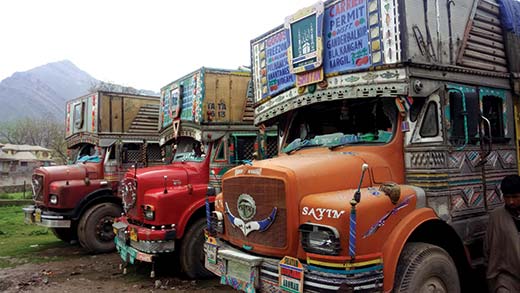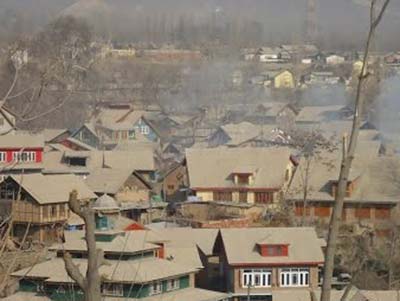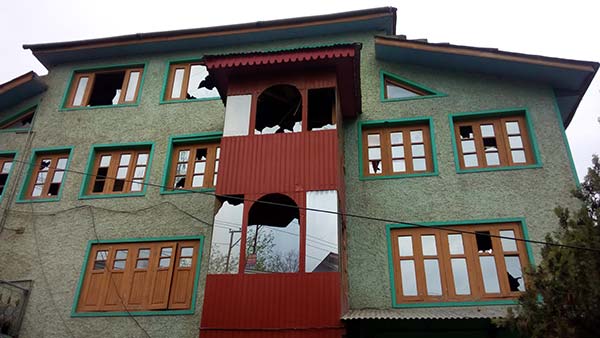Khrew’s rise to fame as Kashmir’s cement capital is dusted with promises, pain, rivalries, and choked lungs. Bilal Handoo tells the story of cement through the prism of Khrew’s current standoff

Boulevard to Khrew is strewn with empty-dusty row of stalled trucks. People in small groups are dourly discussing the standoff hitting the region since Feb 9, 2016. Further down the road, in the main bazaar, near the freshly-cropped cemetery, lie windshield-smashed trucks, windowpane-shattered houses and pellet-shell littered yards. Amid signs of ruin, there exists pack of atrocious accounts about state action on rural populace demanding justice for survival.
And thus begins the story of cement…
Throwback to mid-seventies and people recall a sudden arrival of J&K’s Congress chief minister, Mir Qasim with his caravan in Khrew. He had come to lay foundation stone for Kashmir’s first cement plant. In a tough language, Qasim declared: “People of Khrew, your good days are about to begin. A cement plant is coming up in Khrew.” Before some possible voices of dissent would erupt, Qasim roared: “This decision has been taken at highest level and it cannot be rolled back.” And with that, the villagers entered into the deal, promising them ‘better life’ with the coming of government-owned, JK Cement Limited.
By 1981, the cement plant had begun functioning in Khrew—then thriving on saffron, walnut, almond and paddy. Those were the signs of self-sufficiency for this postcard village.
Then cometh the cement, and cometh the change.
One obvious change was the ‘new’ life for the villagers, promising jobs, free electricity, quick bucks and much more. It was a convincing change, apparently a departure from the ‘weary’ rural life. To cement their positions in the cement plant, Khrew along with other neighbouring villages joined hands to form Zaffran Truck Union.
Now, without the union’s permission, the cement company couldn’t ferry shipments from Khrew. To be the part of this neo-economic activity, the erstwhile farmers sold their share of land to buy trucks, apparently to make quick ‘fortunes’. Everything was changing in Khrew—thick and fast—from economy to environment.
It was a new growth story, where cement was fast providing a degree of self-sufficiency to Kashmir. Both numbers and equations on ground were changing. It was perhaps the beginning of new Kashmir linked with cement. To facilitate the change, thick plumes of smoke and dust began rising over Khrew nestled in Pulwama district. Over the years, as story of local cement became Rs 1100 crore industry, Khrew became Kashmir’s cement capital.

But akin to every twisted tale, Kashmir’s cement story had its conflicting plot. As Kashmir’s timeline passed through troughs and turbulences during nineties, the ‘ambitious’ JKCL went haywire. In face of dwindling workforce, frequent power cuts and imbalanced demand-supply ratio, the company lost its market to the emerging private players, making moolah in neo-economic activity.
In between, JKCL—producing 550-tonnes per day (tpd)—continued to struggle for survival. To boost it, the government in 2003 approved setting up of Rs 87.50 crore additional 600-tpd plant at Khrew. But by the time ex-CM Ghulam Nabi Azad went to lay its foundation stone, it had overrun its costs.
Since then, the fall continues. With 850 employees, JKCL has no salary to pay. The company is also indebted to various financial institutions and vendors to pay huge amounts besides amassing liabilities of over Rs 100 crore.
Back in Khrew, the latest flashpoint appears “deep-rooted”, aimed at “undoing the status quo”. While huddling inside a ransacked house near Khrew’s paralysed bazaar, the villagers raise a pitch to unmask the real face behind the agitation. “We oppose Waseem Trumboo’s motive to set up another cement plant, Super Max, in Khrew,” says an elder. “To penalise the villagers, he encouraged our partners in Zaffran truck union—Androssa and Bathen—to float separate truck union called Alkhudham for ferrying cement shipment from Khrew.” The decision became the moot point behind the present day standoff, thus stalling a fleet of around 1000 trucks on the dusty roads of Khrew.
As Khrew’s old union continues to rally behind the status quo, the reluctance of the cement factories is now costing dear to both sides. The loss is already running in multiple crores.
Amid deadlock, the state administration got involved, ordering the rebel truck union to ferry cement shipments under security cover. But the move backfired, forcing Khrew to pitch a tent on road in protest. State swiftly reacted with baton, smoke, pellet and pepper, thus sending Khrew packing behind doors for days together. Then, the high court swung into action, ordering the status quo in Kashmir’s cement capital, producing 1000 tonnes of cement daily.
But far from the commotion-caught Khrew, Kashmir’s cement story is getting exciting. Only private players produce 80,000 bags a day. But the production is yet to match the consumption. Compared to yearly requirement of 15.40 lakh tonnes of cement, the domestic production only stands at 7.50 lakh tonnes. Rest is still being exported.
However, the cement players are upbeat to meet the soaring demand, if only they could explore Kashmir’s 3500 million tonnes of limestone reserve—the raw material for manufacturing cement—a bit more. Another positive is Kashmir’s cement growth—10 percent against the all India average of 7 percent.
Among the private players, Trumboos are numero uno. Primarily in flour and tea industry, the known business family shifted its focus to cement in 1994. Today, its authorized share capital stands at Rs 5,000,000.
Starting with a capacity of 200 tpd, the Khyber cement has been one of the fastest growing companies in cement sector in valley, clocking a growth of around 100 percent. Presently, the company has the capacity of around 400 tpd.
In Khrew’s neighbourhood, Khyber Cement has state-of-the-art plant in Khonmoh Srinagar. The company with the help of the latest Danish rotary technology has wide network of more than 3000 dealers across the state. The company presently employs more than 600 employees directly and generates employment for more than 10,000 people indirectly.
Another important player is TCI MAX having 400 tpd capacity in their existing plants. The new plant made by TCI at Khrew is said to have advanced dry process technology. The plant is designed by German based Polysius and will provide direct employment to 600 people and indirectly to 3000 persons.
But in view of valley’s surging cement requirement, many outside cement companies never stop coming to Kashmir to fill the void. Among them, prominent was Shree Cements. With its 600-ton per day capacity plant at Kathua, the company’s Rs 164 crore project was approved by the governor at the peak of 2008 Amarnath land row. Shree’s local market venture had marked the end of local monopoly over the sector, gradually heading towards self-sufficiency. Certain quarters smelled conspiracy behind the move after it was known that a seasoned Congressman’s son was keen to see it a reality.
The approval had come after the earlier governments discouraging non-local investment in local cement sector. Earlier, Gujarat cement giant Ambuja had failed to get an approval even after shelling out a few crore. Similarly, Dalmia’s had approached the ex-CM Mufti Sayeed for investing Rs 1000 crore in creating a huge cement plant. But it never saw the light of the day.
In all this, Khrew with its 20,000 population, remained a bedrock of Kashmir’s cement story. The figures suggest that the hamlet contributes 840 crore per annum to the state economy—making it the second contributor to the state economy after J&K Bank.
March 2009 was Khrew’s watershed year after four more cement plants cropped up. Today, Khrew’s 450 kanals of land—including forest and grazing land—houses seven cement plants: JKCL, TCI, Dawar, Cemtac, Green Valley, HK Cements and ICC.

To make Kashmir slightly self-sufficient in cement, Khrew paid a huge price. The World Health Organisation has already declared it a “deadly town”, having highest death rate than any other town in the district due to these poisonous gases.
With 30 graves dotting the Khrew’s landscape every year, the WHO report leaves nothing for imagination. Even Khrew’s seven springs have lost their pristine akin to its proud saffron—falling from 385 kg to 78 kg in production.
But Khrew chose economy over environment. And now, when the same economic wheel stands halted, it is getting nostalgic. Maybe, south Kashmir’s Shahabad Dooru had foreseen the shadow of the coming events when they refused to house cement plant. Perhaps, it wasn’t a bad bet, given how Khrew’s fleet of 1000 trucks has been gathering dust from last 60 days.















